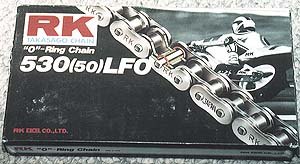RK 530LFO Chain and Vortex Sprockets
There is an old maxim: "Always change the sprockets whenever you replace your chain." This is good, solid advice -- heed it. That is also why we are presenting this product review as a doubleheader featuring both an RK chain and a set of Vortex sprockets. To add frosting to this review, we decided to include before and after performance figures, since worn drivetrain components can rob your bike of power. Our test bike was an 1986 Suzuki GSXR1100 with a highly modified motor. After 16,000 miles of use the old chain was stretched unevenly and had several tight spots, though it still moved freely and there were no kinks in it. The old sprockets had worn teeth that looked pointy and ugly. This is not good. Considering the power of the bike, new components were necessary, but not before we dyno'd the bike to get a baseline for our RK and Vortex test. Would we see a difference in power changing nothing but the chain and sprockets? Indeed we did?
Let's take a look at the Vortex sprockets. The steel countershaft sprocket has been machined with a diamond cutter, which work-hardens the steel and enhances durability. The 530 unit we used was black and had a nice, smooth surface on one side of the sprocket teeth, while the other side had slight ridges on the edge where it contacts with the chain rollers. The countershaft sprocket is made to spin one direction. We installed it with the smooth surface of the teeth bearing the load under acceleration. The rear Vortex sprocket is CNC machined out of 7075 aerospace aluminum.
Some manufacturers stack blank sprockets and cut the teeth into them all at once, then later cutting out the hub holes and bolt holes. The peril of this approach is that the teeth might not be concentric with the hub, which leads to a sprocket with an offset center. Vortex avoids this hazard by CNC machining each sprocket individually. The machining marks are not polished off, giving the rear sprocket a burly, high-tech look. Adding to that effect are the dramatic accents machined into the aluminum between the bolt holes and between each of the teeth. In a word, it looks trick. A special coating is added to the rear sprockets to make the aluminum brighter. Both front and rear sprockets bolted on with no fuss.
Retail price for the Vortex sprockets is on the high side, running from $52 to $56 for the rear and $11 to $22 for the countershaft.
Contact information: Vortex: 800-440-3559 RK Chains: See your local dealer or call 760-732-3161
More by Kerry Ward































Comments
Join the conversation